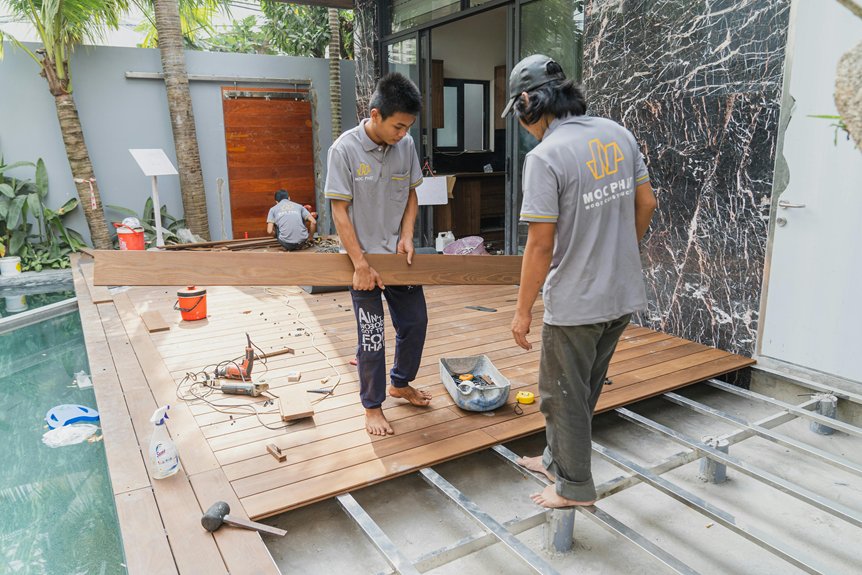Building a deck involves selecting appropriate materials that suit your needs and budget. Pressure-treated timber is often chosen for its affordability, while composite decking offers enhanced durability. For those seeking long-lasting, low-maintenance options, PVC and aluminium are excellent choices.
Costs can vary significantly, as hardwoods provide longevity but tend to be more expensive initially. To ensure your deck remains in good condition over the years, regular cleaning, inspections, and weatherproofing are essential.
Modern composite materials not only enhance the aesthetic appeal but also promote sustainability by incorporating recycled components. Proper maintenance is key to preserving the deck’s appearance and overall value.
In the following sections, we will explore how to select the most suitable material for your specific requirements and ensure your outdoor space brings you enjoyment for years to come.
Choosing the Right Decking Material
Choosing the right decking material is a significant decision that hinges on various factors, including budget, climate, and individual taste.
Pressure-treated wood stands out for its affordability but requires regular maintenance to prevent issues such as warping and rot.
Composite decking, which blends wood and plastic, offers durability and low upkeep, though it may not provide the natural aesthetic some homeowners desire.
PVC decking is excellent for resisting moisture, mould, and pests, necessitating minimal care; however, it tends to be on the more expensive side.
Vinyl decking shares many of these beneficial qualities but typically has a limited palette of colour options.
On the other hand, aluminium decking is incredibly durable and weather-resistant, although its modern appearance may not appeal to everyone.
Each material presents its unique advantages, making it crucial to assess how they align with your lifestyle and outdoor space.
This careful consideration will help you create a welcoming, functional deck that you’ll enjoy for years to come, as selecting the right material can also enhance your property’s value.
Comparing Costs and Longevity
When comparing the costs and longevity of decking materials, it’s essential to recognise that initial expenses can differ significantly based on the chosen material.
Pressure-treated wood is typically the most economical option, offering an affordable solution for those on a budget. However, while it may be cost-effective initially, its lifespan is considerably shorter, usually lasting around a decade or so with appropriate maintenance.
In contrast, hardwoods such as Ipe provide a more premium choice. Although the upfront investment is higher, these materials can endure for several decades, boasting impressive durability that rivals concrete.
Composite decking presents a middle-ground option, often combining the benefits of both wood and synthetic materials. This type of decking tends to offer a good balance between cost and longevity, appealing to homeowners seeking a durable outdoor solution.
PVC decking is another alternative that’s known for its outstanding longevity, often exceeding several decades. While it requires a larger initial expenditure, the long-term benefits in terms of durability and low maintenance can justify the investment.
Additionally, many composites are made with recycled materials, which makes them a more eco-friendly option and contributes to sustainability.
Maintenance and Durability Considerations
Regular maintenance is crucial for keeping a deck in excellent condition and prolonging its lifespan.
Routine cleaning is essential; sweeping weekly helps prevent dirt, leaves, and debris from causing stains or fostering mould growth. Monthly deep cleaning with gentle soap and water ensures the surface remains fresh and inviting. Proper cleaning solutions are essential to avoid damaging the deck material.
When it comes to inspection, checking for loose fasteners, damaged boards, or signs of rot is vital. Addressing these issues promptly can prevent more significant problems down the line.
Weatherproofing is another key aspect, which involves applying water-repellent finishes annually and ensuring proper drainage to ward off moisture damage.
To manage wear and tear, minor scratches can be sanded smooth, while severely damaged boards should be replaced without delay.
Enhancing Aesthetics and Sustainability
Advancements in composite decking technology have significantly enhanced the aesthetic appeal of outdoor spaces while supporting sustainability initiatives. Many composite materials now integrate recycled wood fibres and plastics, which reduces the reliance on virgin timber and new plastics. They’re fully recyclable at the end of their lifespan, aligning with principles of a circular economy. Some composites even utilise sustainable raw materials, such as bamboo fibres, which help to mitigate deforestation. These decks don’t require chemical treatments or paints, thus minimising pollution. Aesthetic enhancements include realistic wood grain textures and a variety of colours and finishes, allowing homeowners to personalise their outdoor areas. Additionally, modern designs feature hidden fasteners, contributing to a cleaner, more streamlined appearance. Recyclability and eco-friendly materials further enhance their appeal by reducing environmental impact over their lifespan.
Conclusion
Selecting the appropriate decking material is influenced by several factors such as budget, durability, and aesthetics. Evaluating costs and expected lifespan is essential for making a well-informed choice, ensuring long-term value for your investment.
Regular upkeep can significantly extend the lifespan of your deck while maintaining its visual appeal. Furthermore, opting for sustainable decking solutions can be environmentally beneficial without compromising on style.
Overall, grasping these fundamental considerations enables homeowners to design a safe, attractive, and enduring outdoor area that is customised to their preferences.

